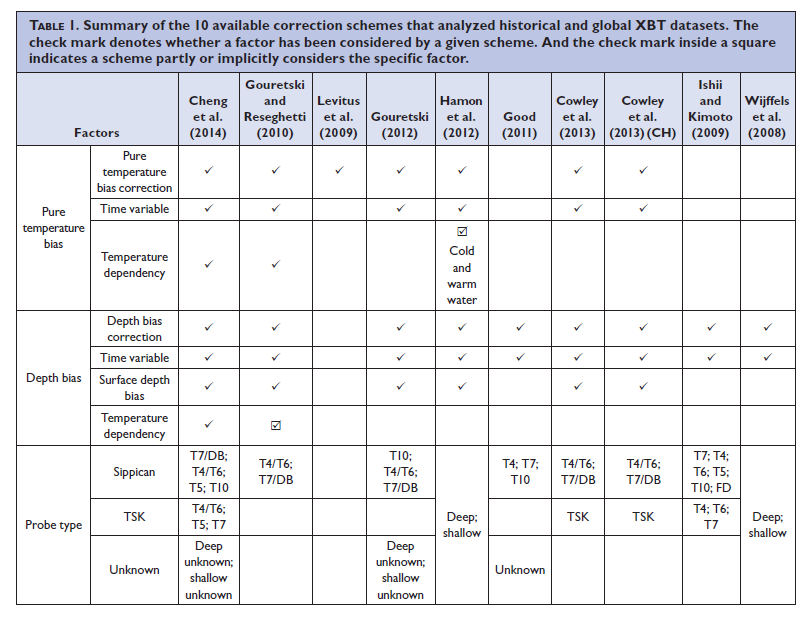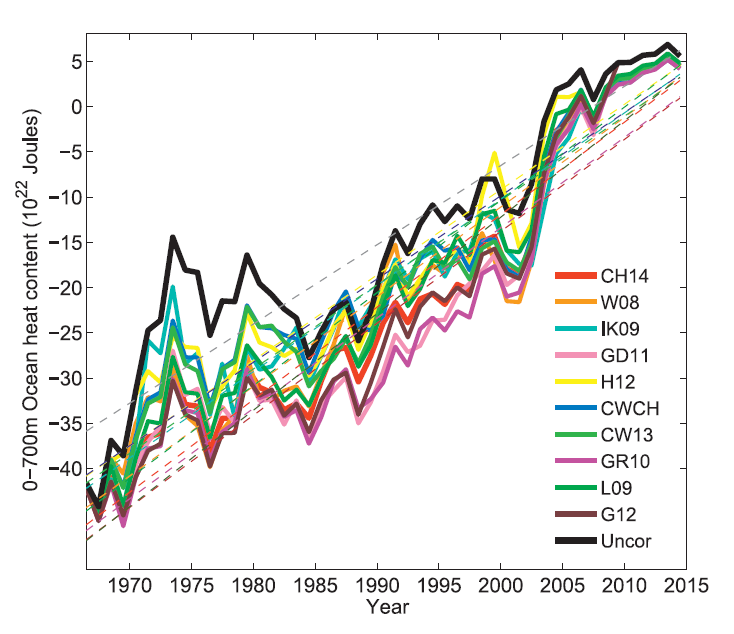Background
XBTs do not measure depth directly (e.g. via pressure). Instead, fall-rate equations are used to derive the depth of the XBT as a function of time after the XBT is deployed into the ocean:
where z(t) is the depth of the XBT in meters, and a, b are constants determined using theoretical and empirical methods. top
XBT Accuracy
The XBT has an accuracy of ±2% or 4.6m in depth (whichever is greater) and ±0.2°C in temperature. The XBT performs well within these levels of accuracy and is acceptable for most types of research. Researchers using XBT data for climate studies such as ocean heat content changes and thermosteric sea level change have found that inaccurate fall rate coefficients and a temperature bias have a significant impact on their calculations. The fall-rate and temperature bias vary over the years since the introduction of the XBT in 1967.
Collection of XBT and CTD pairs is vital for the future correction of XBT biases. Cowley et al (2013) constructed a database of over 4,100 XBT and CTD co-located profile pairs (available at http://dx.doi.org/10.4225/08/52AE99A4663B1) and this database will be regularly updated as new pairs become available. Continued collection of co-located XBT and CTD pairs is imperative for monitoring XBT the fall-rate and temperature bias into the future. Collecting the XBT/CTD paired data requires international cooperation, since data from all ocean basins and latitudes are needed. Performing XBT testing at sea is generally not an onerous task, but does require some pre-planning and organization. The XBT Science Team encourages sea-going researchers to conduct these tests whenever possible, and submit collected data for inclusion in the XBT/CTD pairs database. Please contact Rebecca Cowley for support and information about collecting pairs data.
topNew Fall-Rate Equation Coefficients
During the Fourth XBT Science Workshop, the participants agreed that in order to correct systematic errors in the historical XBT dataset, the following corrections (which are equally important) should be performed in order to improve the quality of XBT data:
- 1) Fall-rate equation (FRE) coefficients. The coefficients a and b in the FRE have been shown to have variability in time, and and that variations in the FRE coefficients existed due to probe type and manufacturer In addition, it has also been shown that the systematic depth errors are a function of water temperature, once viscosity is highly dependent on its temperature, which affects the probe motion.
- 2) Pure temperature bias correction. The pure temperature biases are not originated from the depth estimates and are temperature dependent. Studies have shown that XBT recording systems have the largest impact on the pure temperature bias. Analog recording systems were mainly used before 1985 and have been found to produce positive pure temperature biases of approximately ~0.15°C. Digital systems, which were mainly used after 1989, usually produced smaller biases, in most cases with positive values ranging from 0.01°C to 0.07°C. The pure temperature bias is also due to inaccuracies in the data acquisition system (thermistor, copper wire, cables, digitizer, electronics, and computer). It has been also reported that the pure temperature bias is variable with time and probe type. This bias has been observed to robustly increase with the temperature of water flowing past the XBT thermistor.
- 3) Depth offset correction. Recent studies show that the XBT depth can be better corrected by adding an offset term to the FRE (depth = at – bt2 – offset). This idea was largely introduced for the reduction of subsurface (i.e., 0–50 m) depth bias, which could not be achieved only by modifying the two coefficients in the traditional FRE. The XBT terminal velocity has been assessed and it was determined that the XBTs take up to approximately 1.5 s or 20 m to reach their terminal velocity after they hit the water. Comparisons between XBT and CTD measurements indicate that there is a depth bias in the initial probe descent period (upper 50 m).

Summary of the 10 available correction schemes that analyzed historical and global XBT datasets. The check mark denotes whether a factor has been considered by a given scheme. And the check mark inside a square indicates a scheme partly or implicitly considers the specific factor. Table obtained from Chen et al., (2016)
At the present time, members of the community recommend the Cheng et al. (2014) corrections be used because the scheme currently provides the most appropriate bias correction strategy as discussed above, including all of the recommended factors.
Ocean Heat Content (OHC) is an indicator of the amount of heat stored over a certain depth range in the ocean. The major source of error for historical OHC estimates comes from the XBT biases. It has been shown that the long-term OHC trend calculated by using uncorrected XBT data was underestimated by a half (Figure below 3). Application of the Chen et al., (2014) correction scheme provides more accurate estimates of the OHC.

Upper (0–700 m) OHC calculated using corrected XBT data and the uncorrected XBT data (Uncor; black curve). The XBT data are corrected using 10 of the schemes, including Cheng et al. (2014; CH14). The annual mean of global OHC anomaly (OHCA) is calculated by simply averaging the 1° × 1° grid means of OHC average over the global ocean. Figure obtained from Chen et al., (2016)
For further information, please consult Chen et al., (2016) and Cheng et al. (2014)
References
Cheng, L., Abraham, J., Goni, G., Boyer, T., Wijffels, S., Cowley, R., Gouretski, V., Reseghetti, F., Kizu, S., Dong, S. & Bringas, F. (2015). XBT Science: assessment of instrumental biases and errors. Bulletin of the American Meteorological Society, (2015)..
Cheng, L., Zhu, J., Cowley, R., Boyer, T., & Wijffels, S. (2014). Time, probe type, and temperature variable bias corrections to historical expendable bathythermograph observations. Journal of Atmospheric and Oceanic Technology, 31(8), 1793-1825.
Cowley, R., Wijffels, S., Cheng, L., Boyer, T., & Kizu, S. (2013). Biases in historical Expendable BathyThermograph data: a new view based on side-by-side comparisons. J. Atmos. Oceanic Technol., 30, 1195–1225, (2013)
Goes, M., G.J. Goni, and K. Keller (2013), Reducing Biases in XBT Measurements by Including Discrete Information from Pressure Switches. J. Atmos. Ocean. Techn., 30(4), pp.810-824, 10.1175/JTECH-D-12-00126.1
Gouretski, V. (2012), Using GEBCO digital bathymetry to infer depth biases in the XBT data, Deep Sea Research-I, 62,40-52.
Hamon, M., Reverdin, G., and Le Traon, P. Y. (2012). Empirical correction of XBT data. Journal of Atmospheric and Oceanic Technology, 29(7), 960-973.
Di Nezio, P.N., and G. Goni (2011), Direct Evidence of Changes in the XBT Fall-rate Bias During 1986-2008. J. Atmos. Ocean. Techn., 28(11), 1569-1578,doi:10.1175/JTECH-D-11-00017.1.
Good, S.A (2011), Depth biases in XBT data diagnosed using Bathymetry data ,Journal of Atmospheric and Oceanic Technology, 28, 287-300, doi: 10.1175/2010JTECHO773.
Di Nezio, P.N., and G. Goni (2010), Identifying and Estimating Biases between XBT and Argo Observations Using Satellite Altimetry. J. Atmos. Ocean. Techn., 27(1):226-240.
Gouretski, V. and F. Reseghetti (2010), On depth and temperature biases in bathythermograph data: Development of a new correction scheme based on analysis of a global ocean database. Deep-Sea Research I, Vol. 57(6), pp. 812-834, doi:10.1016/j.dsr.2010.03.011.
Ishii, M. and M. Kimoto (2009), Reevaluation of Historical Ocean Heat Content Variations With An XBT depth bias Correction. J. Oceanogr. 65, 287299, doi:10.1007/s10872-009-0027-7.
Levitus, S., Antonov, J. I., Boyer, T. P., Locarnini, R. A., Garcia, H. E., and Mishonov, A. V. (2009). Global ocean heat content 1955–2008 in light of recently revealed instrumentation problems. Geophysical Research Letters, 36(7).
Wijffels, Susan E., Josh Willis, Catia M. Domingues, Paul Barker, Neil J. White, Ann Gronell, Ken Ridgway, John A. Church (2008), Changing Expendable Bathythermograph Fall Rates and Their Impact on Estimates of Thermosteric Sea Level Rise. J. Climate, 21, 56575672. doi: http://dx.doi.org/10.1175/2008JCLI2290.
Gouretski, V. V., and K. P. Koltermann (2007), How much is the ocean really warming? Geophysical Research Letters, L01610, doi:10.1029/2006GL027834.
A complete list of references to XBT biases can be found here.
top